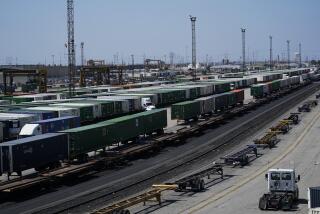‘Widespread fraud’ in California’s smog test program
Nearly a third of older-model cars stopped for roadside smog tests in Southern California failed them, despite having received a passing grade at inspection stations within a year, a state audit has found.
The results of those surprise inspections of 6,000 models manufactured before 1996 have led law enforcement officials to crack down on unscrupulous stations, step up fines and file more criminal charges.
Legislation introduced in the California Assembly this week would allow the state to bar low-performing test stations from conducting smog checks.
“We found widespread fraud in the program,” said Leo Kay, spokesman for the California Air Resources Board, which is sponsoring the bill.
“There are quite a few people out there who will get your dirty car passed,” said Tom Cackette, deputy director of the board. “You can stick a probe up the tailpipe of a clean vehicle. And the dirty car doesn’t get inspected but it gets certified. We put people in jail for that. Undercover activity shows it is prevalent.”
The legislation, introduced this week by Assemblyman Mike Eng (D-Monterey Park), also would fundamentally change how the majority of inspections are done. Testers would be required to use a hand-held scanner that reads data from on-board computers found on post-1996 cars, which report the vehicle’s performance over time. Tailpipe-and-treadmill testing, which is more susceptible to manipulation and fraud, will be phased out as older cars leave the state’s roads. Bill backers expect the test, used in 22 states, to take half as much time, which could drive down prices for consumers.
The computer device would register the car’s model and VIN, making fraud difficult. Information gleaned from onboard computers, which monitor components from catalytic converters to gas caps, would go directly to the state Bureau of Automotive Repair.
Some 23 million motorists are included in the state’s smog test program and would be affected by the proposals. Cars made before 1996 constitute only a quarter of the fleet but account for three-quarters of vehicle pollution, the board says.
By cracking down on smog check stations, the state estimates it will prevent an additional 70 tons of pollutants per day from fouling California air, on top of the 400 tons daily that the smog test program is credited with averting.
“This new and improved program will have the same result as taking 800,000 old cars off the road,” said board Chairwoman Mary D. Nichols.
The random tests were conducted by California Highway Patrol and Bureau of Automotive Repair officials between 2000 and 2006. They found that 19% of the stopped vehicles failed tailpipe checks within a year of having received passing grades at testing stations. Additional inspection of the car’s pollution systems, such as fuel evaporation controls, brought the proportion of failures to 31%.
Sherry Mehl, chief of the auto repair bureau that oversees the smog check program, called the results “appalling.” But she added that the fault may not lie exclusively with stations. “One part is people manipulating their own cars to get them to pass, and the other part is stations manipulating,” Mehl said. “As a consumer, you can go onto websites and learn all kinds of different ways and additives to get your car to barely pass a smog check.”
The roadside tests also revealed a high failure rate for cars that initially failed smog checks, were repaired and then were given passing grades after a subsequent test. Of those, 59% failed roadside tests within a year of the second station test.
“A significant number of cars that failed the initial test got repaired,” Cackette said. “But within days after a retest, we saw them on the roadside and they had high emissions.”
The roadside tests were compared with the station’s records for the same vehicles, and the results were analyzed in an independent report by Sierra Research, a Sacramento auditing firm. The firm reported its overall results last March, but the air board kept them under wraps until this week while officials prepared a legislative response.
Mehl said an improved data transmission system between the auto repair bureau and individual stations, installed last April, has allowed officials to focus on 200 stations that are “the worst of the worst.”
Before June 2009, only one or two stations were cited for fraud each year, she said. Since June, 22 stations have had their licenses suspended; 17 of them are facing criminal prosecution. The legislation would raise the ceiling on fines from $2,500 to $5,000.
Susan Ward, executive director of the California Emissions Testing Industries Assn., which represents smog-check testers, said her members do not object to stepped-up enforcement but added that fraud is less widespread than portrayed by state officials.
“Just because you are pulled over and don’t pass the test doesn’t mean there’s fraud,” she said. “These are the dirtiest vehicles. An old car with high mileage can float above and below the cutoff point in a smog check, depending on how long you’ve driven it, how it is maintained and what the outdoor temperature is.”
More to Read
Inside the business of entertainment
The Wide Shot brings you news, analysis and insights on everything from streaming wars to production — and what it all means for the future.
You may occasionally receive promotional content from the Los Angeles Times.











